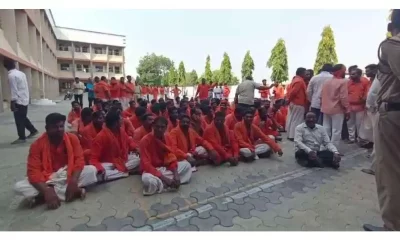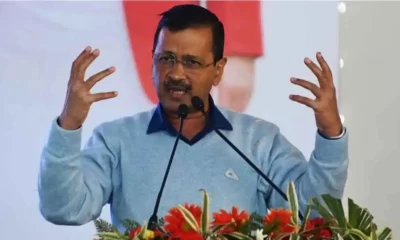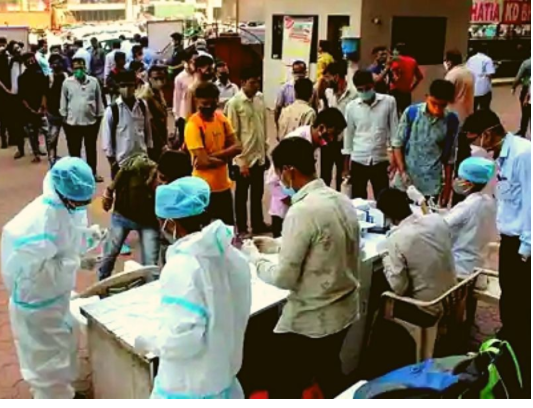Blogs
eSHRAM and Informal Workers
the Union Ministry of Labour and Employment launched the much-awaited eSHRAM portal – the National Database on Unorganized Workers (NDUW) to digitize registration of all unorganised sector workers of India and to link them with the various social security and protection schemes.

In welcome news, the Union Ministry of Labour and Employment launched the much-awaited eSHRAM portal – the National Database on Unorganized Workers (NDUW) to digitize registration of all unorganised sector workers of India and to link them with the various social security and protection schemes. There are more than 38 crore informal workers in India; hardly a fraction is registered with the worker associations, unions or the labour departments in states, or nationally.
Through this portal, a worker can register in herself/himself by giving details like Aadhar card number, bank account details, apart from filling in other necessary details like date of birth, native place, mobile number, income certificate and social category and will be issued an eShram card containing a 12-digit unique number. To begin with, targets have been set to register unorganised workers from Bihar, Andhra Pradesh, Gujarat, Assam, Chhattisgarh and Delhi by the end of this year.
While the demand for the smooth registration mechanisms under the labour department has long been voiced by the labour movements, the issue came to centre stage in 2020, during the first lockdown when media reported on distress migrant movement and the government did not have any estimates about number of informal workers or social security provisions it could make available.
Later, the National Human Rights Commission (NHRC) through its advisories on Informal Workers and the Supreme Court (SC) both took note of the situation and pushed for accountability of the welfare state by seeking the creation of such mechanisms.
The first step in a long-awaited need for recognition
The worker collectives, trade unions, NGOs and platforms of workers have welcomed the initiative with the expectation that this will further strengthen the labour market and improve wages and working conditions of informal workers, especially women and other vulnerable workers. Furthermore, such a mechanism will also enhance, accountability of the state to the workers of India who for years have been relegated to not just precarity, but also to an invisible existence.
The recent growth of the gig economy in India has also increased the crevasse between worker and welfare protections. This is visible in the angst of gig or platform workers who are uncovered by any labour legislation. The labour codes which aimed to cover these workers are yet to see the light of the day on the ground. Keeping these aspects in view, this portal is seen as the first step to link workers with social security and to be a medium to get recognition to the informal workers such as gig workers amongst other categories of workers including migrant, domestic, street vendor, agricultural workers, home-based workers etc.
If the initiative is integrated with other existing mechanisms in the state and gets backed by a grounded information campaign about its usefulness, it can be an important step to develop and strengthen a mechanism of migrant worker facilitation in both source and destination districts and states.
Many aspects at play
In terms of challenges one can envisage that the diversity within the unorganized sector workers, lack of understanding about the need for registration and social security coupled with poor digital penetration may pose a problem. Though the government has launched a national toll-free number 14434 to assist and address the queries of the workers it is yet to be seen how many people come forth to get registered and in what capacity.
It will be important to enlist the support of unions, workers associations, NGOs and platforms in advancing this effort, and high-intensity district-level information campaigns need to be undertaken by the state governments. It will also help if unions, associations, and NGOs working with informal workers are also given identifications to help register informal workers, mechanisms for which need to be worked out.
The self-registration process enabled through this portal is, yet another milestone for the empowerment of labour. While most of the data sought can be filled by self, the requirement of uploading certificates such as education, occupational and income stands out as it is these documents which surely labourers such as agricultural, home-based workers, domestic workers and several other categories will find it difficult to produce at the time of registration.
Interestingly, the portal allows one to register and issues the e-card without these documents being uploaded. How the lack of these documents plays out while verification of worker for social security one has no way to find out at this stage. There are other features like seeking information on skillsets and formal training which hints at a broader skill development plan in mind.
During the registration process, the portal has created a list of 156 categories of informal work, a list which perhaps would need expansion as this process deepens. There are other elements such as the need for information on the current residential address etc that needs a rethink. Many workers particularly in cities, are homeless or stay in temporary residential arrangements. Such a necessity may lead to exclusion. Then there is the question of elderly workers over 60 years of age who are excluded without reason especially when pensions are meagre and not all are linked with it.
Last but not the least, the requirement to initiate the process itself through a mobile number linked with Adhaar Card may keep away many workers from getting registered. The informality and migrant nature often force these workers to keep frequently changing their mobile numbers on account of payment lapses, and this prevents the linkage of mobile numbers with Adhaar Cards.
In all, addressing some of these issues will help in making the process easier for workers to be registered, and access entitlements and social security
Questions for tomorrow
While there is a mention of some schemes such as accident insurance and benefits out of Pradhan Mantri Suraksha Bima Yojana (PMSBY), the larger question is what is the overall social security package will be provided once the worker is registered. Not only has the implementation of the Unorganised Workers Social Security Act 2008, been poorly done from which lessons could to be drawn, even in the Code on Social Security 2020, there is also no specificity on what overall quantum of social security will be provided to the informal workers of India.
Also Read: Hitting the right chord and creating soulful music is an inspiring music artist from UK: Tevan
One hopes that the portal opens the avenue to realise the dream of every worker to get dignified social security as per the ILO convention on Social Security (Minimum Standards) Convention, 1952 of which India is a signatory and moves a step further to formalise work arrangements.
The Parliamentary Standing Committee on Labour, in its recently released its report titled “Impact of COVID-19 on Rising Unemployment and Loss of Jobs/Livelihoods in Organised and Unorganised Sectors” noted “formalising the Unorganised Sector, increasing the productivity, strengthening and upgrading the existing livelihoods and creating new opportunities should remain the major thrust areas to mitigate the impact of Covid-19 pandemic on unemployment and joblessness. The Committee also said that the social security measures need to be strengthened and made attractive. Further, the Government should explore ways and means to put money in the bank accounts of the informal workers during adverse conditions like Covid-19”
We believe that this registration should not be an end, but a first step to ensure various accountabilities; one of the welfare state vis a vis establishing the identity of the “informal” worker as a maker of India, and its responsibility for social welfare, protection and security; second of the employers for their actions and contributions towards protection and advance of rights and entitlements of workers. The latter, is a missed opportunity in this mechanism.
Sandeep Chachra and Smita Khanijow.
Blogs
Fueling Rural Entrepreneurship: Small Business Loans Revolutionizing Rural India

New Delhi (India), July 15: Rural areas form the backbone of India’s economy, with a vast population engaged in agriculture and small-scale enterprises. However, accessing financial resources to fuel rural entrepreneurship has traditionally been challenging. Small business loans have emerged as a powerful tool in revolutionizing rural India, providing much-needed capital to aspiring entrepreneurs and driving economic growth. In this blog, we will explore how small business loans are transforming the rural entrepreneurial landscape, fostering innovation, creating employment opportunities, and uplifting rural communities.
Encouraging Agripreneurship and Diversification:
Agriculture-based businesses are the lifeline of rural India. Small business loans enable rural entrepreneurs to venture into agripreneurship and diversify their agricultural activities. These loans facilitate investments in modern farming techniques, equipment, and infrastructure, enhancing productivity and profitability. Additionally, entrepreneurs can explore value-addition opportunities, such as food processing, organic farming, and agricultural services, creating new revenue streams and reducing dependence on traditional farming practices.
Promoting Rural Micro, Small, and Medium Enterprises (MSMEs):
Micro, small, and medium enterprises (MSMEs) play a crucial role in rural development and employment generation. Small business loans cater specifically to the needs of rural MSMEs, providing financial support for business expansion, technology adoption, and market diversification. These loans enable entrepreneurs to establish and grow businesses in sectors such as handicrafts, textiles, cottage industries, and rural tourism. By promoting rural MSMEs, small business loans contribute to the overall socio-economic development of rural communities.
Bridging the Infrastructure Gap:
Rural areas often face infrastructure challenges, such as inadequate transportation networks, limited access to electricity, and lack of storage facilities. Small business loans address these issues by enabling entrepreneurs to invest in infrastructure development. Whether it’s setting up rural warehouses, cold storage units, or transportation services, these loans empower entrepreneurs to bridge the infrastructure gap. Improved infrastructure not only facilitates the growth of rural businesses but also attracts investments, creates employment opportunities, and enhances the overall quality of life in rural areas.
Empowering Women in Rural Entrepreneurship:
Small business loans are empowering rural women to break gender barriers and participate actively in entrepreneurship. These loans provide financial support to women entrepreneurs, enabling them to start businesses, acquire assets, and access markets. Additionally, loan programs often incorporate skill development and capacity-building initiatives tailored for women entrepreneurs. By encouraging women’s participation in rural entrepreneurship, small business loans contribute to gender equality, women’s empowerment, and the economic progress of rural communities.
Strengthening Local Supply Chains and Market Linkages:
Small business loans play a vital role in strengthening local supply chains and market linkages in rural India. Entrepreneurs can utilize these loans to enhance their production capabilities, improve product quality, and establish robust distribution networks. By connecting rural businesses with larger markets, these loans enable entrepreneurs to access better pricing, expand their customer base, and increase their profitability. Strengthening local supply chains not only boosts rural businesses but also promotes sustainable economic growth and reduces rural-urban migration.
Small business loans have emerged as a powerful force in revolutionizing rural India. By fueling rural entrepreneurship, these loans promote agripreneurship, boost rural MSMEs, bridge infrastructure gaps, empower women, and strengthen local supply chains. As more entrepreneurs in rural areas gain access to capital, they contribute to economic growth, employment generation, and the overall development of rural communities. It is imperative for financial institutions, government agencies, and other stakeholders to continue expanding small business loan programs and providing targeted support to rural entrepreneurs. Through these efforts, we can unleash the full potential of rural India and build a more inclusive and prosperous nation.
Blogs
January 2023 starts with positive prospects for the price of gold

Even in 2023, many traders share an interest in gold, not just because this is one of the most popular precious metals, but also thanks to the accessibility of gold (or other gold derivatives) trading. With growing political uncertainty, 2022 ended on a disappointing note for bulls, but 2023 is a whole other story, and prospects seem to be more optimistic.
Past performance should not be treated as a 100% accurate forecast tool, but there are a few variables that gold bulls should keep in mind, moving into 2023.
Seasonality
The first of these variables is seasonality, and the good news is that January continues to be the most suited month for the price of gold to rise, based on data going back to 1972. More specifically, the average monthly returns in January are estimated at 1.6%, followed by 1.0% in February.
During the last several months, central banks around the world increased their gold reserves at an irregular pace, as a result of geopolitical factors. Once Russia started the war on Ukraine, assets held by high-ranking businessmen and Russian institutions were seized. This makes liquid assets such as US Treasuries less attractive, especially when it comes to countries that have an antagonistic view compared to the USA.
Peak USD bullishness?
According to data available on the website of Easymarkets, gold is trading at around $1,800 after a slow but steady recovery, beginning November 2022. This is a result of peaking USD performance against other currencies.
The FED hiked rates fast, which meant flows favoring the Dollar, and that in turn did not act as a tailwind for gold. Now that the USD has seemingly paused its rally, gold has more room to go up, unless risk aversion once again becomes dominant in the market.
In terms of macroeconomics, US inflation is already slowing, while Europe and Japan seem to be lagging by at least a few months. The same goes for economic conditions, which can be seen deteriorating worldwide. That is not supportive of a continued rise of inflation and at some point, it could be a reason for the FED to pivot and start cutting interest rates.
Interest rates
When plotting the price of gold on top of US Treasury rates, a negative correlation can be spotted. Rates up lead to gold going down and since the market is already anticipating a peak in tightening, government bonds are set to rise in 2023.
That means interest rates have less upside potential, supporting a continued rise in the gold price as the year starts. Remember that all financial assets, regardless of risk profile, are sensitive to interest rates, because they affect market liquidity, as well as the discounting effect for future returns.
There are no certainties when predicting where gold will be at the end of January, but if seasonality, the US Dollar, and interest rates act as a confluence of positive factors, the first month of 2023 can continue the precious metal’s rise.
Blogs
An Insight Into Legality Of Horse Racing Betting In India

Regarding gambling, few countries have such a long and fascinating history as India. Horse racing is one of India’s most popular forms of betting and has been for centuries.
Horse racing betting is an activity loved by locals and fantastic entertainment, highly valued internationally. The industry employs millions of people, including jockeys, trainers, and grooms, and fills stadiums worldwide with passionate punters.
However, there are still many questions about whether or not online horse betting is legal in India. To try and understand more about the legalities involved and get an insight into horse racing betting in India, more generally, has become more critical than ever before. In this article, we take a look at some of these issues to clear up any confusion that may arise when considering wagering on equine events in the nation.
What is the Legal Status of Horse Racing Betting in India?
The legal status of horse racing betting in India is complicated. While it is considered legal and regulated, certain restrictions apply to the activity.
For example, online betting on horse races is not allowed, and only approved physical racecourses are permitted to offer this service. Additionally, specific regulations have been put in place by the Central Government’s Ministry of Home Affairs, which states that any form of gambling or wagering must occur within a licensed premise or area.
This means that even if you were to find a way to bet on a horse race online, you would still be required to visit an authorized racetrack or facility to do so physically. Fortunately, you can check our recommended sites for betting on horse races in India, which are approved by the government and operate within the confines of the law. The listed websites are reliable and secure, allowing you to place bets without the worry of any legal repercussions.
Therefore, while it is possible to bet on horse racing in India legally, the activity must be done within a licensed and regulated environment.
How Can I Bet on Horse Racing in India?
If you’re looking to place a bet on a horse race in India, the best way to do so is by visiting the nearest licensed racetrack. Here, you will be able to find one of the many bookmakers available and get started with your betting.
When placing a bet at the track, it is essential to remember that you must be 18 or over to participate and that all bets must be made in Indian Rupees (INR). Before placing any wagers, it is also essential to familiarise yourself with all applicable laws. It is also important to note that any winnings from horse racing betting must be declared and taxed accordingly.
Horse Racing vs. other forms of gambling
Horse racing betting is a form of gambling which has been around for centuries and is seen as one of the most popular forms in India. In comparison to other forms of gambling, such as casino games or sports betting, horse racing betting offers a much more traditional and social experience.
In addition to this, because it is only allowed at licensed racetracks, it is also considered safer than other forms of online gambling, which the government does not regulate.
Cricket betting is also hugely popular in India, with many people wagering about the outcome of cricket matches. While this form of gambling has been legalized in recent years, it is still considered illegal if done online. This means that cricket betting must be done through licensed bookmakers at physical premises or racetracks.
Tips for Horse Racing Betting in India
When betting on horse racing in India, there are a few tips that you should keep in mind.
- Choose Your Racetrack Carefully – Not all racetracks are created equal, so choosing the best suits your needs is crucial. Research the track’s history and review any reviews or ratings.
- Do Your Research – Before placing a bet, do your research and get to know the horses you are betting on. Look at their past performances and find out about their trainers and jockeys.
- Set a Budget – Gambling can be an addictive activity, so it is vital to set yourself a budget and stick to it. This will help ensure you don’t overspend and stay within your means when betting on horse races in India.
- Understand the Odds – Before placing a wager, it is essential to understand the odds. This will help you make an informed decision and ensure you get the best value for your money.
- Utilise Technology – Take advantage of technology and use apps or websites to track results, compare odds and get tips on which horses are likely to perform well in upcoming races.
- Check the rules and regulations of the racetrack you’re visiting to ensure that your bets are within the limits and guidelines.
Following these tips ensures that your horse racing betting experience in India is safe and enjoyable.
General requirements to take part in Horse Racing Betting in India
To take part in horse racing betting in India, you must be 18 or over and have an Indian ID that can be used to verify your age. Additionally, you will need to provide proof of residence and a valid credit/debit card for online transactions.
Furthermore, it is essential to remember that all races are governed by the rules and regulations of the track in which they are held, so it is necessary to familiarise yourself with these before placing any bets. Also, it is essential to note that horse racing betting is only allowed at licensed racetracks, so it is necessary to check the licensing status of any track you visit.
Conclusion
In conclusion, horse racing betting in India is legal and regulated, but certain restrictions apply to the activity. To ensure a safe and enjoyable experience when placing bets, it is important to familiarize yourself with all relevant laws and regulations and do your research before wagering on any horses. Additionally, choose your racetrack carefully and set a budget, so you can avoid overspending or get into financial difficulty.
-

 Entertainment15 hours ago
Entertainment15 hours agoBollywood stars Vidya Balan, Kartik Aaryan, Pratik Gandhi, Ileana D’Cruz, Mouni Roy, Radhika Madan, Mrunal Thakur attend Do Aur Do Pyaar premiere
-

 LATEST SPORTS NEWS20 hours ago
LATEST SPORTS NEWS20 hours agoIPL 2024: Delhi Capitals thrash Gujarat Titans by 6 wickets
-

 Cricket news14 hours ago
Cricket news14 hours agoHappy Birthday KL Rahul: Suniel Shetty wishes son-in-law KL Rahul on his 32nd birthday
-

 India News17 hours ago
India News17 hours agoReligious outfit vandalises The Blessed Mother Teresa High School in Telangana after teachers object to students wearing Hanuman Deeksha dress
-

 India News18 hours ago
India News18 hours agoClashes erupt during Ram Navami procession in West Bengal’s Murshidabad district
-

 India News13 hours ago
India News13 hours agoEnforcement Directorate seizes Shilpa Shetty’s husband Raj Kundra’s properties worth Rs 97 crore
-

 India News11 hours ago
India News11 hours agoEnforcement Directorate says Arvind Kejriwal is deliberately eating mangoes, sweets, taking sugar with tea to increase his blood sugar level and create ground for bail





